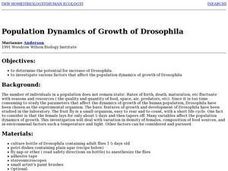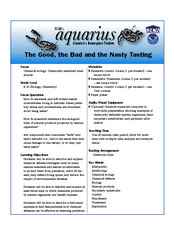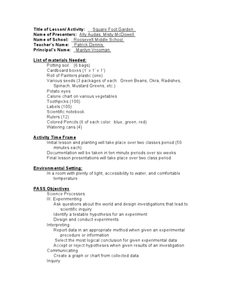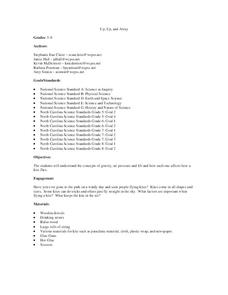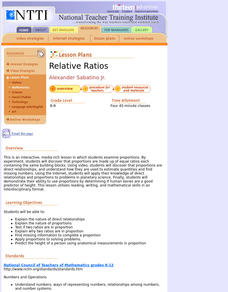Curated OER
Day and Night
Students using experiments try to demonstrate how observations can be affected by the cycles of night and day.
Curated OER
Learning Lesson: Moonlight Serenade
Students complete experiments as they act as the earth. They observe how different angles affect the phases of the moon seen by us. They discuss the differences in light and dark.
Curated OER
Zigzag Seeds
Students observe the effects of gravity on seeds. Students place seeds in various orientations and record their growth to determine how gravity affects the seeds' growth.
Curated OER
Bricks Soak Up Water
Students determine whether various rocks are porous or not. They conduct an experiment to determine if a brick is porous, calculate how much water the brick soaked up, and develop a conclusion.
Curated OER
Water Flow Through Local Soils
Learners examine the relationship between particle size and rate of water flow through soil. They collect soil samples, make predictions, conduct a water flow experiment, analyze the data, and answer conclusion questions.
Curated OER
States of Matter
Students categorize items into one of the three states of matter. They participate in a demonstration in which they represent particles of matter. Finally, they complete an experiment in which they "race" top see who can make acetone...
Curated OER
How Many? How Far? How Thick?
Fifth graders examine the role of magnetism and electricity. In groups, they are given different types of magnets and discover how the magnetic force differs for each one. They measure the amount of distance a paper clip moves toward...
Curated OER
Population Dynamics of Growth of Drosophila
Students experiment with Drosophila to determine if density of female flies, food sources, temperature and light affect the population dynamics of growth. Students graph their data and compare their results to the number of human...
Curated OER
Exploring Magnetism
Twelfth graders experiment with magnets in order to visualize that magnets have a north and south pole, some materials can be magnetized, and magnetization occurs because of the magnetic moments of individual molecules in matter.
Curated OER
Newton's Third Law of Motion
Seventh graders are introduced to Newton's Third Law of Motion. In this physics lesson plan students examine the concept of thrust as one of the forces acting on aircraft.
Curated OER
Sounds Around
In this sounds worksheet, students choose one of five activities to do at home with parents. Students experiment with making sounds with natural objects, list "noisy" foods or count all the outdoor sounds that can be heard.
Curated OER
The Good, the Bad and the Nasty Tasting
Students examine the effect of chemicals from marine plants or animals on predator's preferences. In this ecology lesson, students conduct taste tests and collect necessary data. They write their conclusion after analyzing experimental...
Curated OER
Aqua-Thrusters!
Students construct their own rocket-powered boat called an "aqua-thruster." These aqua-thrusters will be made from a film canister and will use carbon dioxide gas - produced from a chemical reaction between an antacid tablet and water -...
Curated OER
Growing Your Own Snow Crystals
Students grow snow crystals in your classroom with a few materials and a two-liter bottle!
Curated OER
Square Foot Garden
Students plant a garden and keep track of it. In this geometrical garden lesson plan, students collect data from their garden twice a week. They graph their finding and figure out how many square feet of growing space each person needs...
Curated OER
Structures and Behaviors of Planarians
Students investigate planaria of the phylum platyhelminthes. They use DigiScope technology to observe and describe the structure and movements of planarians.
Curated OER
Beads, Balls, and Beakers
Young scholars analyze the amount of space required to pack round objects. In this geometry instructional activity, students practice using space economically by practicing packing spheres into beakers. They then translate this concept...
Curated OER
How Do Things Fall?
Students study forces by examining the force of gravitational attraction. They observe how objects fall and measure the force of gravitational attraction upon objects. Students discover that, since gravitational constants are different...
Curated OER
Sand or Rock? Finding Out From 1,000 km
Young scholars observe how measurements are made with different instruments. In this remote sensing activity students investigate the physical state of surfaces including the surfaces of the solar system.
Curated OER
Inventions- The Impact
Students discuss the impact of certain inventions. In this technology lesson plan, students research Thomas Edison and the light bulb on the Internet and discuss how the invention impacted society. Students create their own simple...
Curated OER
Up, Up and Away
Tenth graders experiment with gravity and air pressure. In this geometry lesson, 10th graders build their own kits and fly it. They investigate the questions: what keeps a kite in the air and what are some important factors when flying a...
Curated OER
Gravity: It's GREEEAAATTT!
Students calculate effects of gravitational force on planets, discuss the effects of weightlessness on the human body and describe and demonstrate how objects in a state of free fall are accelerated by gravity at an equal rate.
Curated OER
Mixing and Stirring
Students experience mixing through dancing. In this physical science lesson plan, students not only dance to show mixing but also demonstrate mixing and stirring by combining milk and chocolate milk.
Curated OER
Relative Ratios
Students discover that proportions are made up of equal ratios each containing the same building blocks. They, using the Internet, apply their knowledge of direct relationships and proportions to problems in planetary science.









